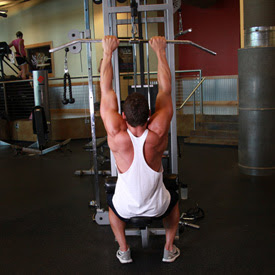DECLINE BENCH DUMBBELL FLAYS
1. Secure your legs at the end of the decline bench and lie down with a dumbbell on each hand on top of your thighs .The palms of your hand will be facing each other .
2. Once you are lying down , move the dumbbells in front of you at shoulder width . The palms of the hands should be facing each other and the arms should be perpendicular to the floor and fully extended . This will be your starting position .
3. With a slight bend on your elbows in order to prevent stress at the biceps tendon , lower your arms out at both sides in a wide arc until you feel a stretch on your chest . Breathe in as you perform this portion of the movement .
TIP:- Keep in mind that throughout the movement , the arms should remain stationary; the movement should only occur at the shoulder joint .
4. Returns your arms back to the starting position as you squeeze your chest muscles and breathe out .
TIP:- Make sure to use the same arc of motion used to lower the weights .
5. Hold for a second at the contracted position and repeat the movement for the per scribed amount of repetitions .
VARIATIONS:- You may want to use a palms facing forward version for different stimulation .







